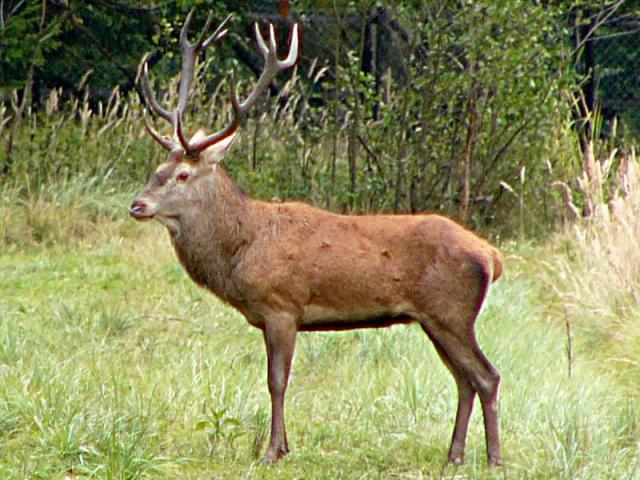Scientific classification:
Kingdom: Animalia
Phylum: Chordata
Class: Mammalia
Infraclass: Eutheria
Order: Artiodactyla
Suborder: Ruminantia
Infraorder: Pecora
Family: Cervidae
For most deer in modern English usage, the male is called a "buck" and the female is a "doe", but the terms vary with dialect, and especially according to the size of the species. For many larger deer the male is a "stag", while for other larger deer the same words are used as for cattle: "bull" and "cow". The male Red Deer is a "hart", and the female is a "hind". Terms for young deer vary similarly, with that of most being called a "fawn" and that of the larger species "calf"; young of the smallest kinds may be a kid. A group of deer of any kind is a "herd".
Occurance: Today just on Central Europe's western half can be found in the largest number. Considerable deer substance which can be hit on Hungary, the South-Transdanubian areas, some 30 000 deer lived where the domestic substance is his half in 1996.
Habitat: With clearings and meadows coloured lombos- and mixed forests.
Morphology, construction: The advanced temperature, the homoiothermia, that is the body temperature to be stood near, the heat insulation is typical of the mammals universally maid hair. The deer ruminant: in the course of this after the consumption of the nutrients the food retches (ruminates), it is consumed again then. Like this the food so it is chewed two times.
The intestinal canal was transformed in the course of this nutritional manner. The stomach consists of four parts properly, that is complex. After the oesophagus the first stomach (rumen) can be found, the honeycomb stomach follows it (reticulum). The third part the leveles- the third stomach (omasus). Finally the real one, abomasum (abomasus). Their dentition adapted to the plant eating well; than the rest of the one chewing the cud, the deer ones do not have upper incisors, their place the hard spur of the palate can be found.
Their body generally slender, their spine straight and long. They run well on the wooded soil with their strong foot, they jump perfectly and they swim.
An antler, which is specific according to the race, sits on the head of all of his horn bulls. The vestigial antler of the female may increase rarely, but the antler of the female of the reindeer emerged only yes. The antlers are taken off in all years, and new one is grown instead. The antler is growing from the so-called rose who. Rich leather, so-called bast cover the developing antler in veins. Before the beginning of the bell under the bast the antlers ossifies, the deer rubs the bast off him then. Soft, gristly fabric, which furthers the detachment of the antler, forms between the antler and the rose after the mating period.
Nourishment: They feed with the undergrowth, mainly with the letters of the bushes generally. Their stomach at the rest of the ruminant one's smaller, did not become specialized, they have to eat plants with bigger nutritive value because of this. Since they eat roughly so much, than the sheep and the horned cattle, the horn ones select the youngest foldings, the young letters, grasses, twigs, fruits, mushrooms and lichens.
Reproduction: The cows, doe generally one you are two, they give birth to three calves very rarely. The pregnancy lasts until ten months. The newborn calf of most races whitely spotted; as a woman, the dots disappear. He has learned to be to the first 20 minutes of his newborn life. The dam licks away at it till then his calf, the predators find him in heavier one so while it becomes odourless one. The calf sits until a week being concealed in the grass while enough will not be strong to it in order to be allowed to follow his mother. The two animals are left together until a year, then separate. The bulls do not see more of their mothers, the females generally on the other hand they recur with their calves, and into little herds they set.
Protection: in Europe already since centuries in a merit and resolutely dealt the big game and particularly the acknowledged leader animal, with the hind substance's long-term maintenance, with providing him for his conditions of existence, even from wildlife parks, even from other hunting grounds.
